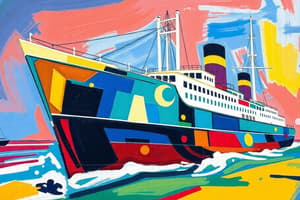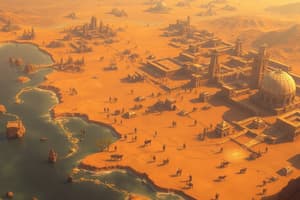Podcast
Questions and Answers
Which of these ship designs were used for trade in the 14th to 17th centuries?
Which of these ship designs were used for trade in the 14th to 17th centuries?
- Carrack
- Caravel
- Fluyt
- All of the above (correct)
What shape is a lateen sail?
What shape is a lateen sail?
Triangle
What characterizes a trading-post empire?
What characterizes a trading-post empire?
Based on small outposts rather than large territorial control
What is the Columbian Exchange?
What is the Columbian Exchange?
What was the Great Dying?
What was the Great Dying?
An isolationist believes in close relationships with other countries.
An isolationist believes in close relationships with other countries.
What is the Mita System?
What is the Mita System?
What is Chattel slavery?
What is Chattel slavery?
What characterized an indentured servant?
What characterized an indentured servant?
What is cultural synthesis?
What is cultural synthesis?
What is a monopoly in the context of trade?
What is a monopoly in the context of trade?
What was the Encomienda system?
What was the Encomienda system?
What did the Hacienda system involve?
What did the Hacienda system involve?
What was the Casta system designed to ensure?
What was the Casta system designed to ensure?
What is mercantilism?
What is mercantilism?
What is a joint-stock company?
What is a joint-stock company?
Who were the Russian Boyars?
Who were the Russian Boyars?
What were Ottoman Timars?
What were Ottoman Timars?
Flashcards
Caravel
Caravel
A fast, maneuverable ship with lateen sails used by Portuguese and Spanish for exploration and trade during the 15th to 17th centuries.
Fluyt
Fluyt
A Dutch ship designed for efficient trade, featuring square sails and a large cargo capacity, used extensively in the 16th and 17th centuries.
Lateen Sail
Lateen Sail
A triangular sail that allows ships to catch wind from either side, enabling flexible navigation in various directions.
Trading-post Empire
Trading-post Empire
Signup and view all the flashcards
Columbian Exchange
Columbian Exchange
Signup and view all the flashcards
Great Dying
Great Dying
Signup and view all the flashcards
Isolationist
Isolationist
Signup and view all the flashcards
Mita System
Mita System
Signup and view all the flashcards
Chattel Slavery
Chattel Slavery
Signup and view all the flashcards
Indentured Servant
Indentured Servant
Signup and view all the flashcards
Cultural Synthesis
Cultural Synthesis
Signup and view all the flashcards
Monopoly
Monopoly
Signup and view all the flashcards
Encomienda System
Encomienda System
Signup and view all the flashcards
Hacienda System
Hacienda System
Signup and view all the flashcards
Casta System
Casta System
Signup and view all the flashcards
Mercantilism
Mercantilism
Signup and view all the flashcards
Joint-stock Company
Joint-stock Company
Signup and view all the flashcards
Russian Boyars
Russian Boyars
Signup and view all the flashcards
Ottoman Timars
Ottoman Timars
Signup and view all the flashcards
Study Notes
Ship Designs
- Carrack: A ship with square and lateen sails, utilized by Portugal for trade between the 14th and 17th centuries.
- Caravel: A ship featuring lateen sails, favored by the Portuguese and Spanish for fast, long-distance voyages during the 15th to 17th centuries.
- Fluyt: A Dutch ship designed with square sails, used for trade in the 16th to 17th centuries.
- Significant advancements in ship design propelled maritime exploration and trade, facilitating the Columbian Exchange.
Lateen Sail
- A triangular sail that allows ships to capture winds from either side, enabling various directional travel.
- Primarily used by Arab sailors in the Indian Ocean, revolutionizing navigation during the Middle Ages.
- Crucial in expanding trade routes by allowing exploration of vast water bodies.
Trading-post Empire
- An empire characterized by smaller trading outposts instead of large territorial control, exemplified by the Portuguese model.
- Facilitated Portuguese dominance in trade, allowing for monopoly over the spice trade between Malacca and Hormuz.
Columbian Exchange
- A transcontinental exchange of goods, diseases, and cultures between the Western and Eastern hemispheres.
- Resulted in significant demographic shifts, altering populations and biodiversity worldwide.
- Influenced economic developments and historical trajectories globally.
Great Dying
- A catastrophic epidemic spurred by the introduction of Old World diseases during the Columbian Exchange.
- Led to the death of approximately 90% of the native population in the Americas due to lack of immunity.
Isolationist
- Refers to individuals or groups advocating for limited engagement with foreign affairs, especially politically and religiously.
- In Japan, isolationism led to expulsion of Christian missionaries and stringent restrictions on foreign merchants and Japanese travel.
Mita System
- An Incan labor system requiring young men to contribute labor to public projects, later adapted by the Spanish into forced labor.
- Essential for mining operations in the silver industry, significantly boosting the Spanish economy.
Chattel Slavery
- A form of slavery wherein individuals are treated as property to be bought and sold, prevalent in American plantations.
- Fueled the rise of the plantation economy, permanently replacing indentured servants as the primary labor source.
Indentured Servant
- Individuals who contracted to work for a set number of years in exchange for passage, not permanent laborers.
- Played a crucial role in early economic structures, eventually overshadowed by the rise of chattel slavery.
Cultural Synthesis
- The mixing of cultural influences resulting from continuous contact among different cultural groups.
- Led to the creation of new languages and religions, enhancing demographic diversity and intermarriage.
Monopoly
- Exclusive trade rights granted to specific merchants or governments, manipulating trade networks.
- In the 15th and 16th centuries, the Portuguese dominated the spice trade in the Indian Ocean, taxing non-Portuguese traders.
- Spanish government established a monopoly on tobacco in American colonies, creating substantial profits.
Encomienda System
- A coercive labor system introduced by the Spanish to exploit indigenous populations for gold and resources.
- Often brutal and harsh, significantly diminishing native populations and causing widespread suffering.
Hacienda System
- Agricultural estates that flourished through coerced labor, producing crops like wheat and sugar.
- The Spanish crown granted land to conquistadores, leading to economic exploitation and a reliance on slave labor following the decline of indigenous populations.
Casta System
- A racial classification system in Spanish colonies designed to maintain European dominance.
- Determined individuals' social status, taxation levels, and legal rights, deeply influencing colonial society.
Mercantilism
- An economic theory prioritizing the export of goods to accumulate wealth, minimizing imports to preserve national treasures.
- Shaped government approaches to economic regulation and national wealth enhancement.
Joint-stock Company
- Organizations formed to pool resources among merchants, distributing risks and costs associated with colonization.
- Vital for financing exploration and trade in the Americas, with notable examples including the Virginia Company and Dutch East India Company.
Russian Boyars
- The noble landowning class in Russia, positioned at the top of the social hierarchy.
- Provided counsel to high-ranking officials and played key roles in legislative decisions.
Ottoman Timars
- Land or tax revenue granted by the sultan to loyal subjects as rewards for service.
- Essential for maintaining control over key officials and ensuring loyalty within the Ottoman administrative structure.
Studying That Suits You
Use AI to generate personalized quizzes and flashcards to suit your learning preferences.




